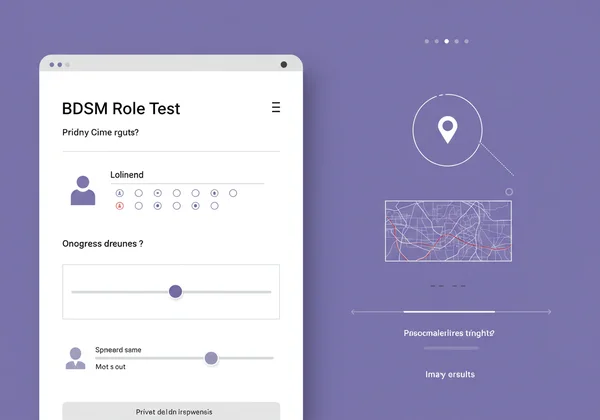主导型BDSM角色:通过免费BDSM测试发现你的力量
准备好释放内在的力量了吗?这是一段能够真正改变你的旅程。你是否被BDSM的世界所吸引,渴望引领、指导和掌控?探索 主导型BDSM角色 的愿望,是一条真实而令人兴奋的自我发现之路。然而,真正的掌控远不止媒体所描绘的简单刻板印象。它是一种巨大的责任、深厚的信任和强大的连接。 我的BDSM角色是什么? 如果这个问题让你产生共鸣,那么本指南将是你的起点。
本指南将深入探讨主导型角色的方方面面,帮助你理解其核心原则,并安全、合乎道德地探索你自身的这个方面。对于那些准备开始系统性自我反思的人来说,免费的 BDSM测试 提供了一种私密而富有洞察力的方式来 开启你的旅程。

理解主导型角色的核心
归根结底,BDSM动态中的主导型角色是领导和指导的角色。它是关于创造一个结构化的空间,让伴侣可以安全地探索他们的臣服面向。这种动态建立在信任和明确同意的基础上,主导者在约定的场景或关系中承担起伴侣福祉的责任。
在BDSM中成为主导者究竟意味着什么?
成为一名主导者,意味着成为一段共享体验的守护者。这需要对自身欲望和界限有深刻的理解,并对伴侣的感受抱有同情心和关注。它并非单纯为了掌控权力,而是利用权力来促成一段双方都满足的动态。一个真正的支配者从精心安排一个能够给其臣服伴侣带来愉悦、释放或成长的场景中获得满足感,同时确保他们的安全和情感保障。这需要自信、清晰的沟通和强大的道德罗盘。
超越刻板印象:掌控的细微之处
流行文化常常将主导者简单化为一种形象:攻击性、命令式、时刻掌控一切。事实上,掌控是一个丰富而多样的光谱。它并不必然与性别、性取向或个性类型相关联。一个内向、富有养育精神的人可以成为一个强大的主导者,正如一个自信、强势的人一样。掌控的表现方式因人而异,也因其与伴侣建立的动态而异。理解这种细微差别是发现你真实领导风格的第一步。

探索不同类型的主导
正如没有唯一一种成为人的方式,也没有唯一一种成为主导者的方式。主导的表现方式多种多样,理解不同的风格可以帮助你识别最能引起你共鸣的方式。这种探索是你理解自己在各种 BDSM角色测试 中潜在位置的关键部分。
主导表达和风格的多样化光谱
主导可以以无数种方式体现。一些主导者严格且有纪律性,而另一些则富有养育和保护性(常见于“父/母式主导(Daddy/Mommy Dom)”动态)。一些主导者正式且仪式化,自称为“Master”或“Mistress”,而另一些则偏好更随意的称谓,或者干脆没有称谓。还有一些“Switches”,他们根据情境享受主导和臣服的角色。认识到这种多样化光谱能赋予你力量,让你不必拘泥于单一的理想。
寻找你的契合点:从精神掌控到身体玩乐
你的主导风格可能更偏向精神层面,也可能更偏向身体层面。“精神主导”(Mind-Dom)擅长精神控制,利用言语、任务和心理游戏来创造权力动态。“绳师”(Rigger)是精通绳缚艺术的主导者,这是一种高强度的体能和高度技巧性的主导形式。许多主导者会融合多种元素,创造出符合其技能和伴侣愿望的独特风格。关键在于发现什么真正能让你兴奋并满足,而在线的 趣味测试 可以帮助你揭示这一点。
健康主导者的责任
在BDSM中,权力不仅仅是一个概念——它是一份深刻的责任。它是确保每一次体验安全、自愿且真正令人愉悦的核心原则。一个健康的主导者并非由其权威定义,而是由其对伴侣福祉的坚定承诺来定义。在探索你主导的一面之前,考虑这一点至关重要。

优先考虑同意、沟通和界限(SSC/RACK/PRICK)
任何健康的BDSM动态的基石都是热情和持续的同意。 安全、理智和自愿(SSC) 原则是最低要求。更现代的框架,如 风险知情同意(RACK) 和 PRICK(个人责任,知情同意的性趣),提供了更细致的理解,承认固有的风险并强调个人责任。一个负责任的主导者会在任何玩乐开始 之前 就清晰地协商好界限,设定明确的限制和安全词,并毫无疑问地尊重这些界限。
有目的的指导:有效地领导你的伴侣
在BDSM中,有效的领导意味着细心和有响应能力。这关乎倾听——不仅是语言,还有身体语言和情绪信号。一个好的主导者知道何时(在获得事先同意的情况下)挑战界限,何时后退。他们带着明确的目的指导体验,无论是为了创造特定的情感状态,探索特定的癖好,还是仅仅为了玩乐。这种有目的的指导将简单的权力交换转化为有意义的连接。
主导动态中善后的重要性
场景结束后发生的事情与场景本身同样重要。“善后”(Aftercare)是指为所有参与者提供的心理和身体护理过程,帮助他们从动态的心理状态中过渡回来。对于臣服者来说,这可能包括保证、身体上的舒适和补充水分。对于主导者来说,这也是一个至关重要的调整和检查自身情绪的时期。提供周到的善后是不可谈判的责任,也是成熟、关爱的支配者的标志。
通过BDSM测试整合你的主导一面
阅读和学习至关重要,但自我反思工具可以为你的好奇心提供一个结构化的框架。在这一点上,由专家设计的资源可以提供宝贵的帮助。它提供了一个私密、无评判的空间,让你在没有压力或期望的情况下探索自己的倾向,对于任何考虑进行 主导与臣服者测试 的人来说,这是一个很好的起点。
我们的免费BDSM测试如何指导你的发现
这款免费在线工具由心理学家和经验丰富的实践者设计,旨在帮助你应对这些复杂的问题。通过在7分制量表上回答一系列陈述, BDSM测试 有助于量化你在各种角色和活动中的倾向。结果可以揭示你对主导、臣服,甚至两者的强烈倾向。它不是诊断,而是一张个性化的地图,帮助你理解你内在的格局并 发现你的角色。

测试之外:主导者的持续学习与成长
将你的测试结果视为起点,一份你当前好奇心的快照。让它们激发你学习和成长的下一步。如果你的结果显示出主导倾向,请继续阅读关于不同的主导风格、沟通技巧和安全规程的内容。加入教育社群,收听播客,并参与来自可信赖的BDSM教育者的内容。主导者的旅程是一个持续成长、学习和完善的过程。
拥抱你的力量:一段自我发现与连接的旅程
探索主导型BDSM角色,是一段深刻的关于力量、信任和连接的旅程。它需要内省、持续学习以及对道德实践的坚定承诺。无论你是充满好奇的新手,还是经验丰富的实践者,真正理解主导的责任和细微之处,对于一段富有成效的探索至关重要。
你的道路是独一无二的。拥抱你的好奇心,始终优先考虑安全,并以清晰的目标去引领。准备好揭示你独特的偏好并迈出下一步了吗? 立即尝试我们的免费BDSM测试,发现你内心的真相。
关于主导型BDSM角色的常见问题解答
在BDSM中成为主导者意味着什么?
成为主导者意味着在BDSM动态中扮演领导角色,这种动态建立在信任、沟通和同意的基础上。它包括指导臣服伴侣的体验,确保他们的身体和情感安全,并从精心构建共享的动态中获得满足感。这是一个充满巨大责任和关怀的角色。
我如何知道自己是主导者还是臣服者?
反思一下是什么真正让你在权力动态中充满活力。 你是否感受到一种引领、保护和为伴侣做决定的冲动?还是你在放弃控制并遵从指导中找到了自由和快乐?没有对错之分。为了获得个性化的起点,参加一个精心设计的 BDSM角色测试 可以提供关于你天生倾向的有价值的见解。
“Master”和“Dominant”有什么区别?
“Dominant”是对任何在权力动态中扮演领导角色的人的宽泛称谓。 “Master”(或“Mistress”)是一个特定、通常更正式的头衔,它暗示着一种更深层、更结构化的关系,有时可能涉及全天候(24/7)的权力关系模式。并非所有主导者都使用Master/Mistress的头衔;这是一个个人选择,取决于动态中的风格和协议。
沟通对主导者来说有多重要?
沟通可以说是主导者最重要的技能。 它对于协商界限、建立同意、理解伴侣的愿望和限制以及提供有效的事后关怀至关重要。没有清晰、诚实和持续的沟通,安全健康的BDSM动态就无法存在。